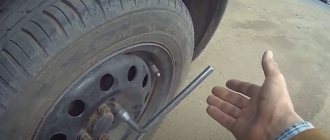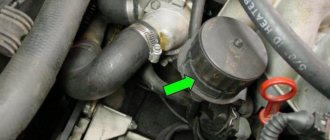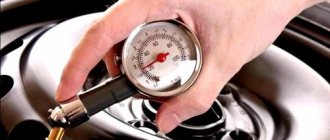Car owners are sometimes faced with the fact that there is no pressure in the fuel rail of a VAZ 2114. In order to understand the causes of this problem and how to eliminate it, it is important to understand the purpose and operating principle of this element.
VAZ fuel rail
The injection engine for the VAZ 2114 car is a power unit with distributed injection, which is carried out through injectors located on the fuel frame. What is a fuel rail? This is a hollow tube with both ends welded. The frame is attached to the engine intake manifold and has a special drain line for excess fuel.
VAZ 2114 fuel supply diagram
To maintain constant pressure in the fuel frame, the VAZ 2114 fuel pressure regulator (RDT) is designed. It is installed slightly above the ramp and has the following feature: when the power plant is stopped and the ignition is turned off, it completely shuts off the fuel supply.
At the same time, high pressure in the fuel rail is maintained for a long time, so that when the engine is turned on, gasoline enters the injectors under normal pressure and starting occurs without delay.
What pressure should the fuel rail be?
The four-cylinder gasoline supply system with an injector includes a fuel rail, which is involved in the uniform distribution of fuel among the injectors. Low pressure in the VAZ 2114 ramp or its absence leads to uneven engine operation. Understanding what pressure should be in the fuel rail will allow you to diagnose problems in the car yourself. Depending on the test option, the normal indicators differ:
- When the ignition is on, the following readings are optimal - 2.8-3 kg/sq.cm ;
- Engine idling is accompanied by the following pressure indicator in the ramp - 2.5 kg/sq.cm ;
- When the return hose is clamped, the pressure in a working system reaches 7 kg/sq.cm ;
- Regasification is accompanied by jumps from 2.5 to 3 atmospheres .
Please note that checking the pressure in the VAZ 2114 fuel rail is impossible without a pressure gauge. This device is sold in auto parts stores. You can also visit a service station to take readings. Understanding what pressure should be in the VAZ 2114 fuel rail, after taking measurements, you can draw conclusions about the state of the system. If there are weak indicators, you should think about cleaning the injectors and ramp.
TIPS THAT MAY BE USEFUL WHEN MEASUREING PRESSURE
- When purchasing a measuring device, you should not take a pressure gauge with a large upper pressure limit (there are pressure gauges designed for 16, 25 kg/cm² and higher). In this case, the accuracy of the device readings will be insufficient, with a large error.
- When relieving pressure in the ramp, you need to stock up on rags and also cover the generator with a rag so that gasoline does not get on it.
- When tightening the pressure gauge fitting, it is advisable to wrap a little tow on the threaded connection, which is used when carrying out plumbing work. The tow will create a tight connection and prevent gasoline from leaking while the engine is running.
How and with what to check the pressure?
It is not possible to measure pressure readings in the fuel system using improvised means. If there is no pressure in the ramp, you can verify this by pressing the fitting located on the left side of the structure with nozzles. You can determine the lack of fuel in this way, but you won’t be able to find out the exact pressure reading without a pressure gauge.
A fuel pressure gauge is a small device with tubes, adapters and a scale with readings. Depending on the type of car, adapters and fittings for quick releases may be needed to work with the pressure gauge. The price for such devices varies from 2.5 thousand rubles for a simple version to tens of thousands for high-precision multifunctional pressure gauges. For personal use, a simple pressure gauge from Russian or Chinese class=”aligncenter” width=”800″ height=”450″[/img] The step-by-step process of checking the pressure readings in the ramp using a pressure gauge looks like this:
- Having prepared the device, attach a hose of a suitable size to it.
- Place the other end of the hose onto the TP fitting, having previously relieved the pressure from it (you can unscrew the nipple on the fitting using a special cap).
- After bleeding the gasoline remaining in the ramp, secure the second end of the hose to the fitting using a metal clamp. Avoid leakage and tighten the clamp firmly.
- Pump fuel into the TR using a fuel pump by turning on the ignition several times.
- Check the pressure through the pressure gauge readings in different modes of engine operation (with the engine not running; with the ignition on; during gas overload and with the return hose clamped).
When reassembling the TP, do not forget to put the cap on the fuel rail in place. Checking the condition of the system using a pressure gauge allows you to identify some malfunctions. Often the cause of low performance in the system is a faulty fuel pressure regulator. When the ignition is on, the pressure gauge should read 2.9-3 kg/cm2. If the instrument needle tends to zero, the RTD is faulty and must be replaced.
If during measurements you observe a “pulsation” of the pressure gauge needle, you should replace the gasoline coarse filter and the mesh in the fuel pump. Often a filter or mesh clogged with dirt leads to poor supply of gasoline to the system. Timely maintenance, replacement of consumables and refueling with high-quality gasoline allow you to avoid such a problem.
Useful : High fuel consumption on the VAZ 2114 (problem solution)
Fuel pump weight
The contact system is normal, but the gasoline level sensor is acting up. Let's see what happens to the mass of the fuel pump. It may be poorly secured. In this case, the fuel pump will not be able to pump anything.
The mass of the fuel pump itself is attached to it in the area of the handbrake, under the dashboard. When you pull the handbrake, you can touch the ground contacts of the fuel pump, and the connection may be lost.
It is not difficult to tighten the mass of the fuel pump, it is difficult to reach it. Namely: get the grounding contact of the ground conducting the lost connection. We remove the plastic under the handbrake and the floor covering of the car, respectively; We clean the contact and firmly attach the mass to the fuel pump.
Why is there no pressure in the fuel rail of the VAZ 2114?
Lack of pressure in the system is a problem for the driver. Most VAZ 2114 vehicles were equipped with gasoline injection systems from the factory. If the pressure in the ramp is low, the movement of the machine becomes impossible. There are several reasons for this malfunction:
- Pump fault. The fuel pump in the “four” is located under the rear passenger sofa. When you turn on the ignition, you can clearly hear its buzzing sound. When the system is sufficiently filled with gasoline, the pump stops. Pump inactivity can be diagnosed by sound or vibration from the cover under the sofa. Often the cause of a fuel pump malfunction is the following: the motor has burned out; relay or fuse has blown; wiring is damaged;
- RTD failure. The design of the regulator contains a diaphragm, which over time loses its properties and ceases to pump a sufficient level of pressure into the nozzles. The problem is solved by replacing the part with a new one;
- Damage to fuel lines and fuel leakage. Because The gasoline supply system in the car is sealed, any leakage is unacceptable. When operating a vehicle, there is always a risk of damage to the lines on the underbody. A leak can also be caused by a poorly tightened filter. Checking the condition of the lines and securely fixing all connections is a sure way to prevent gasoline leaks.
The presence of malfunctions in the operation of the TP indicates possible leaks, damage to the TP or simple clogging of the filter mesh in the fuel pump. The problem is not critical, but if you ignore a malfunction in the gasoline supply system, there is a chance of stalling at the wrong moment right on the road.
see also
Comments 15
My revs have been fluctuating since I bought the car. It rarely happens that the engine runs perfectly smoothly and without interruptions (this is some kind of miracle), and then this lasts no more than 1-2 minutes. And so there are always slight twitches, and the tachometer floats slightly from 840-880 rpm. Already over a distance of 216 thousand km... I tried to look for air leaks, all the hoses (especially the small ventilation of the boat, and from the absorber. Most often, everyone does not hold it tightly, the hose rotates easily.) are sealed with sealant. The rubber seals on the manifold connection were also replaced during disassembly engine. I THINK THAT THE PROBLEM LIES IN A POORLY WRITTEN PROGRAM ON THE ECU, ALTHOUGH IT IS FINE (ALTHOUGH IT IS FISHED). A friend also had a 2114 but 1.5 8V, that’s who I envied at idle speed. Well, it just worked perfectly smoothly, without any twitching. The tachometer stood dead at 860 rpm. Although the car was much older than mine. This is my opinion and what the heck...
I had a V8 converted to an indexer and a VAZ 2111, they didn’t have such a problem, so that when you press the pedal a little, the revolutions would float. There were problems with idle, but everything was solved by arranging an air leak or replacing the sensor, but here I don’t know what else could happen.
My revs have been fluctuating since I bought the car. It rarely happens that the engine runs perfectly smoothly and without interruptions (this is some kind of miracle), and then this lasts no more than 1-2 minutes. And so there are always slight twitches, and the tachometer floats slightly from 840-880 rpm. Already over a distance of 216 thousand km... I tried to look for air leaks, all the hoses (especially the small ventilation of the boat, and from the absorber. Most often, everyone does not hold it tightly, the hose rotates easily.) are sealed with sealant. The rubber seals on the manifold connection were also replaced during disassembly engine. I THINK THAT THE PROBLEM LIES IN A POORLY WRITTEN PROGRAM ON THE ECU, ALTHOUGH IT IS FINE (ALTHOUGH IT IS FISHED). A friend also had a 2114 but 1.5 8V, that’s who I envied at idle speed. Well, it just worked perfectly smoothly, without any twitching. The tachometer stood dead at 860 rpm. Although the car was much older than mine. This is my opinion and what the heck...
Fuse
Fuse 15 A
One of the final stages of checking a malfunctioning fuel pump is its fuse. Like the relay, the fuse can be seen from the inside. Or you can climb in from the outside, through the hood. Under the hood, closer to the windshield, there will be a dark box, right on the electronic control unit. You need to open it and find the topmost fuse with a current of 15 A and the English inscription fuel pump. We take it out and look at the insides: the contact is not damaged - the fuse is alive. The contact is damaged (blown) - you need to install a new fuse. As with the price of the relay issue, buying and replacing a fuse will not be a big waste of money and time.
Not every master's hands grow from the right place. For this reason. The reason that the fuel pump does not pump can be simple stupid shortcomings of simple tuning.
For example, the alarm was installed in such a way that all the contacts were mixed up, and power simply does not go to the fuel pump. Not because the alarm should not be on the car, or the wiring system is acting up, it’s just that the person who installed it didn’t have enough brains and practice. Check all connections carefully if you decide to add some style to your little one.
Or anti-theft. The button is placed in such a way that it interrupts the integrity of the fuel pump ground contact system, and almost always fails. By the way, if you have such a lotion, I don’t think it will be very effective in the absence of a signal. And if there is a signaling system, then anti-theft is not needed at all.
In any case, remember: in any situation where a VAZ breaks down, the point is not that it is a VAZ, and it was made poorly. It’s just that the Russian auto industry is a little more delicate than the foreign one, it requires a little more attention and your ingenuity.
Possible malfunctions of the RTD
Considering that the design of the pressure regulator is mechanical, malfunctions in its operation can occur quite often. The most common device malfunctions include:
- weakening of the membrane spring;
- valve jamming;
- regulator clogging;
- violation of the tightness of the junction of the regulator and the ramp body.
When the diaphragm spring weakens, the valve cannot cope with the air pressure coming from the intake manifold. As a result, the pressure and amount of incoming fuel are reduced.
Valve jamming leads to an uncontrolled supply of fuel to the manifold and its “waste” into the fuel line. In this case, gasoline consumption increases, and the engine stops starting normally due to interruptions in the fuel supply.
Similar signs of malfunction can be observed when the regulator is clogged. Dirt and deposits reduce the throughput of the system, as a result of which the fuel pressure decreases significantly, the engine “chokes”, and normal idle speed disappears.
If the seal between the regulator and the ramp is broken, the air pressure may drop, which again will lead to a decrease in fuel pressure.











